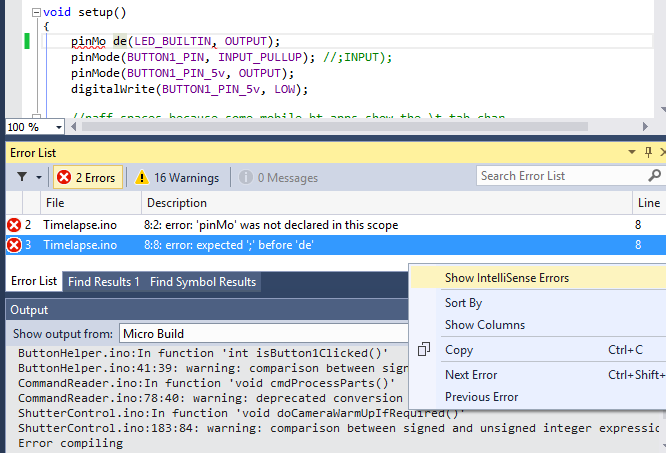

- #Visual micro default release install
- #Visual micro default release serial
- #Visual micro default release software
- #Visual micro default release code
#Visual micro default release serial
Open vMicro > General > Monitor Alternative, and select the USB Port for your TTL Serial Device, a new Serial Monitor Window should appear connected to this port, without changing your upload port. So we can view the additional SoftwareSerial port whilst debugging we will need to make it visible. That's all that's needed, and you can switch back to Serial by changing the USE_SERIAL define now.
#Visual micro default release software
Include the Software Serial Library from vMicro > Add Library > Current Platform.
#Visual micro default release code
To wrap all of your code to be compatible with SoftwareSerial and Serial we suggest you:. When you change to "Release" Configuration this code will deactivate. NOTE - Visual Micro provides _DEBUG automatically if you enable the Project Setting ""Configuration Define _DEBUG" and set its value to 1. If you are not using the Serial Breakout then you can just comment out all Serial Code for now (wrap with a #define to make it easy to switch on and off). This page only provides links to older releases which are not listed in the release database.

Add debug_init() to your setup() routine It builds OK in the Arduino 1.8.4 environment but produces the attached verbose in VM. Python releases are now listed on the downloads page.
#Visual micro default release install
Put this file onto the attached micro:bit will use ufs put to place the currently open file onto the microbit's filesystem (to use this, you'll need to install microfs ( pip install microfs)).Ĭlear files on the attached micro:bit will clear all files stored on the microbit's filesystem.To harness the GDBStub we will need to add a few lines of code: Added commands allowing the microbit filesystem to be interacted with: This extension is also on GitHub:, please file any issues there.Įxtension now allows fetching modules even if the root project folder is named "microbit"Įxtension will now fallback to python3 -m uflash if uflash does not work (on some Windows setups this will fix issues with the build button). Please note that if you plan on using the "Fetch microbit modules" command, and you have a folder inside your workspace named "microbit", it will be deleted! Other Aside from these three dependencies everything else should work for compiling. Python and Pip must be in your PATH variable. Requirements To buildĪnd if you'd like to use the stub library: Provides local emulators and extensions to build, run, and debug cloud apps directly from the editor. Use features and extensions that integrate with Azure and GitHub to develop, debug, and deploy all from one place. Build uses Control + F5 by default on Windows, and Command + F5 on MacOS, but may also be accessed from the title bar, when editing python programs. Spend more time coding and less time switching between tools. FeaturesĪllows code to be compiled onto a micro:bit, and also provides a basic stub of the micro:bit library, so that you can take advantage of Visual Studio Code's features, like Intellisense.Īdds two commands to Visual Studio Code: Fetch and Build,įetch will get the stub micro:bit module from Github, and Build builds the current file to your micro:bit. Basic support for micro:bit with MicroPython in Visual Studio Code.


 0 kommentar(er)
0 kommentar(er)
